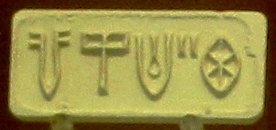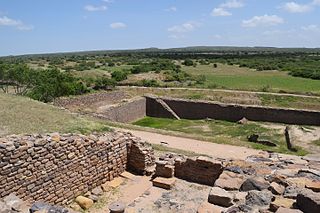Related Research Articles

Dravidian languages are a family of languages spoken by 250 million people, mainly in southern India, north-east Sri Lanka, and south-west Pakistan. Since the colonial era, there have been small but significant immigrant communities in Mauritius, Myanmar, Singapore, Malaysia, Indonesia, Philippines, United Kingdom, Australia, France, Canada, Germany, South Africa, and the United States.

Harappa is an archaeological site in Punjab, Pakistan, about 24 km (15 mi) west of Sahiwal. The site takes its name from a modern village located near the former course of the Ravi River which now runs 8 km (5.0 mi) to the north. The current village of Harappa is less than 1 km (0.62 mi) from the ancient site. Although modern Harappa has a legacy railway station from the British Raj period, it is a small crossroads town of 15,000 people today. The core of the Harappan civilization extended over a large area, from Gujarat in the south, across Sindh and Rajasthan and extending into Punjab and Haryana. Numerous sites have been found outside the core area, including some as far east as Uttar Pradesh and as far west as Sutkagen-dor on the Makran coast of Baluchistan, not far from Iran.

Brahmi is a writing system of ancient South Asia that appeared as a fully developed script in the third century BCE. Its descendants, the Brahmic scripts, continue to be used today across South and Southeast Asia.

The Indus script, also known as the Harappan script, is a corpus of symbols produced by the Indus Valley civilisation. Most inscriptions containing these symbols are extremely short, making it difficult to judge whether or not these symbols constituted a writing system used to record the as yet unidentified language(s) of the Indus Valley civilisation. In spite of many attempts, the 'script' has not yet been deciphered, but efforts are ongoing. There is no known bilingual inscription to help decipher the script, and the script shows no significant changes over time. However, some of the syntax varies depending upon location.

Dholavira is an archaeological site at Khadirbet in Bhachau Taluka of Kutch District, in the state of Gujarat in western India, which has taken its name from a modern-day village 1 kilometre (0.62 mi) south of it. This village is 165 km (103 mi) from Radhanpur. Also known locally as Kotada timba, the site contains ruins of a city of the ancient Indus Valley civilization. Earthquakes have repeatedly affected Dholavira, including a particularly severe one around 2600 BC.

Tamiḻakam, alternatively spelled Thamizhagam, refers to the geographical region inhabited by the ancient Tamil people. Tamilakam covered today's Tamil Nadu, Kerala, Puducherry, Lakshadweep and southern parts of Andhra Pradesh and Karnataka. Traditional accounts and the Tolkāppiyam referred to these territories as a single cultural area, where Tamil was the natural language and permeated the culture of all its inhabitants. The ancient Tamil country was divided into kingdoms. The best known among them were the Cheras, Cholas, Pandyans and Pallavas. During the Sangam period, Tamil culture began to spread outside Tamilakam. Ancient Tamil settlements were also established in Sri Lanka and the Maldives (Giravarus).

Tamil-Brahmi, also known as Tamizhi or Damili, was originally known as a variant of the Brahmi script, but new evidence proves it coexisted with Brahmi. It was used to write inscriptions in the early form of Old Tamil. The Tamil-Brahmi script has been paleographically and stratigraphically dated between the third century BCE and the first century CE, and it constitutes the earliest known writing system evidenced in many parts of Tamil Nadu, Kerala, Andhra Pradesh and Sri Lanka. Tamil Brahmi inscriptions have been found on cave entrances, stone beds, potsherds, jar burials, coins, seals, and rings.
The Bronze Age in the Indian subcontinent begins around 3000 BCE, and in the end gives rise to the Indus Valley civilisation, which had its (mature) period between 2600 BCE and 1900 BCE. It continues into the Rigvedic period, the early part of the Vedic period. It is succeeded by the Iron Age in India, beginning in around 1000 BCE.

Bhirrana, also Bhirdana and Birhana, is an archaeological site, located in a small village in Fatehabad District, in the Indian state of Haryana. Its history stretches back to pre-Indus Valley civilisation times, as revealed by archaeological discoveries, dating to the 8th-7th millennium BCE. The site is one of the many sites seen along the channels of the seasonal Ghaggar river, thought by some to be the Rigvedic Saraswati river.

The earliest undisputed deciphered epigraphy found in India are the Edicts of Ashoka of the 3rd century BCE, in the Brahmi script.

Iravatham Mahadevan was an Indian epigraphist and civil servant, known for his decipherment of Tamil-Brahmi inscriptions and for his expertise on the epigraphy of the Indus Valley civilisation.

There are literary, archaeological, epigraphic and numismatic sources of ancient Tamil history. The foremost among these sources is the Sangam literature, generally dated to 5th century BCE to 3rd century CE. The poems in Sangam literature contain vivid descriptions of the different aspects of life and society in Tamilakam during this age; scholars agree that, for the most part, these are reliable accounts. Greek and Roman literature, around the dawn of the Christian era, give details of the maritime trade between Tamilakam and the Roman empire, including the names and locations of many ports on both coasts of the Tamil country. There are evidences as could be seen comparing standard forms of Sumerian literature and those recovered through present form of Tamil, for example the word for father in Sumerian transliteration is given as, "a-ia" that could easily be compared with Tamil word, "ayya". This also places ancient form of Tamil to early Sumerian period, say as ancient as 3500 BC.
Sembiyankandiyur is an archaeological site in Nagapattinam district in Tamil Nadu, India.

Atiyamāṉ were a royal Velir dynasty. These king-chiefs ruled from their capital Tagadur from at least the 3rd century BCE. The royal house was one of the four kingdoms of Tamilakam, ruling parts of the Kongu Nadu. They were surrounded by the Cheras to the west and the Pandyas and Cholas to the east.
Tissamaharama inscription No. 53 refers to a fragment of black and red ware flat dish inscribed in Brahmi script excavated at the earliest layer in southern town of Tissamaharama in Sri Lanka. It is dated to approximately 200 BC by German scholars who undertook the excavation.

Old Tamil is the period of the Tamil language spanning from 300 BCE to 700 CE. Prior to Old Tamil, the period of Tamil linguistic development is termed as Pre Tamil. After the Old Tamil period, Tamil becomes Middle Tamil. The earliest records in Old Tamil are inscriptions from between the 3rd and 1st century BCE in caves and on pottery. These inscriptions are written in a variant of the Brahmi script called Tamil Brahmi. The earliest long text in Old Tamil is the Tolkāppiyam, an early work on Tamil grammar and poetics, whose oldest layers could be as old as the mid 2nd century BCE. Old Tamil preserved many features of Proto-Dravidian, the earliest reconstructed form of the Dravidian including inventory of consonants, the syllable structure, and various grammatical features.

The Anaikoddai seal is a soapstone seal that was found in Anaikoddai, Sri Lanka during archeological excavations of a megalithic burial site by a team of researchers from the University of Jaffna. The seal was originally part of a signet ring and contains some of the oldest inscriptions in Tamil-Brahmi mixed with megalithic graffiti symbols found on the island. It was dated paleographically to the early third century BC.

Mangulam or Mankulam is a village in Madurai district, Tamil Nadu, India. It is located 25 kilometres (16 mi) from Madurai. The inscriptions discovered in the region are the earliest Tamil-Brahmi inscriptions.

Keezhadiexcavation site is a Sangam age settlement that is being excavated by the Archaeological Survey of India and the Tamil Nadu State Department of Archaeology. This site is located 12 km southeast of Madurai in Tamil Nadu, near the town of Keezhadi in Sivagangai district. It comes under the Thiruppuvanam Taluk of Sivagangai district. This is a large-scale excavation carried out in Tamil Nadu after the Adichanallur archaeological site. The settlement lies on the bank of the Vaigai River and it reflects the ancient culture of Tamil people. Epigraphist V. Vedachalam, who served as a domain expert for the excavation, dated the excavated remains between 6th century BCE and 3rd century CE.

This is a list of archaeological artefacts and epigraphs which have Tamil inscriptions. Of the approximately 100,000 inscriptions found by the Archaeological Survey of India in India, about 60,000 were in Tamil Nadu
References
- ↑ Rajan, K (2008), "Situating the Beginning of Early Historic Times in Tamil Nadu: Some Issues and Reflections", Social Scientist, 36 (1/2): 40–78
- ↑ Lal, B.B. (1962), "From the Megalithic to Harappa: Tracing back the graffiti on the pottery", Ancient India: Bulletin of the Archaeology Survey of India, 16: 21–24
- ↑ Department of Archaeology, Government of Tamil Nadu - Keezhadi, An urban settlement of sangam age on the banks of the river Vaigai (2019) p60-62 https://archive.org/details/keeladibookenglish18092019/page/n59/mode/2up
- ↑ Mahadevan (2001a).
- ↑ Mahadevan (2004).
- ↑ Subramanian (2006).
- ↑ Mahadevan (2006).
- ↑ Subramaniam, T. S. (1 May 2006). "From Indus Valley to coastal Tamil Nadu". The Hindu. Chennai, India. Archived from the original on 24 June 2012. Retrieved 23 May 2008.